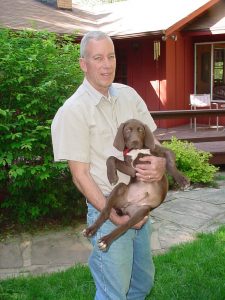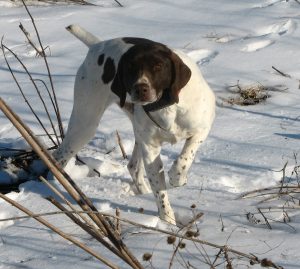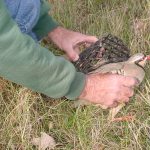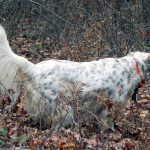Build a Pyramid!
POINTING DOG POINTERS
By Bob and Jody Iler
This past bird season is over and game preserves will be closing in a few weeks. As you evaluate your young pointing dog’s strengths and weaknesses, you might be feeling dissatisfied and impatient with his performance. Maybe you feel as though pup hasn’t made much progress. In some cases, you might think your pup has regressed in certain areas.
Novice pointing dog owners can be susceptible to some unrealistic expectations of what their pups “should” be doing by the end of the first season or two. You might check out Facebook and feel that your friends and their dogs are doing better than you and your pup – as you scroll through their posts! And when you see training kennel ads that boast of having your dog “completely broke” in say, 90 days – you might just get the idea that your pup is lagging behind the norm.
Many of our clients new to pointing dogs express similar sentiments on their initial visits to our kennel. Our started dog program consists of three months of training. Clients share their hopes that pups will be pointing, handling, backing, gun-broke, maybe steady to wing and shot, and surely retrieving to hand by the end of those three months. After all, we’re talking about three whole months!
Clients get a little worried when we mention that we won’t be in a hurry in developing their pups, that we let things unfold according to the pups’ temperaments and abilities. That our main goal at first is to get that pup bird crazy, and that we don’t even worry about pointing at this stage! We want pup to learn to use his nose, to hunt, to find birds, and to chase them with excitement and abandon! With good genetics, if the nose and point are there – it will all come together as pup gains enthusiasm, drive, and maturity.
Once we light the fire in our pup, we’ll add just enough control work to teach pup to handle kindly, without diminishing that flame. And we’ll (very) carefully start the introduction of noise – in the form of clapping hands and blocks together, shooting a popgun, and beginning the progression of gunwork – always making sure that pup is taking things in stride and having fun.
At the end of our started dog program, our goal is to have a pup that is ready and eager to hunt, handles fairly well, has had some yard work (obedience) training, and is developed to the gun. He’s now ready for his first season, where he will continue to learn new and important lessons about hunting wild birds.
We liken this development to building a pyramid – with our impressionable pup at the bottom, then our started dog, and finally, our finished dog at the top. Each stage of development – bird introduction, handling, gun work, yard work, retrieving, honoring or backing, and steadying to wing and shot – are all elements that build upon one another.
These elements cannot be added all at once to your training program. It may take years to get to the top of the pyramid but it’s worth the time and hard work. Some dogs may not have the ability to become a completely finished or “broke” dog, and that’s OK. If your goal is to have a top notch hunting dog, develop your pup for your needs and don’t worry about some of the advanced lessons. It’s not worth ruining a good hunting dog by putting pressure on him to learn things that you don’t really want him to do.
When you begin your training program some questions to ask are: How old is your pup? What are his capabilities? What is his temperament like? How does he react to new challenges? Are you ready to read your pup’s responses to training as you go along? And what do you want your pup to do?
For example, you may want your pup to retrieve but not want him to be steady to wing and shot. Once a started dog gets a season or two below the belt, it’s time to evaluate him. If you see that he is not shaping up as a natural retriever, this is the time to begin a trained retrieve program, which can take several months and a lot of patience.
If you want your dog to be steady to wing and shot, as well as to retrieve, you would wait on the trained retrieve program until your dog is first successfully trained to be steady to wing and shot.
Teaching both of these advanced programs at the same time is a recipe for confusion and undue pressure. Why? Think about it. In teaching your dog to retrieve, you encourage him to run out after the bird is flushed and shot, pick it up, and return to you with the bird. When teaching your dog to be steady to the flush of the bird and the shot, you are encouraging him to do the exact opposite: to stand still and not move when the bird flushes and is shot.
As these early seasons shake out, pups can often exhibit newly learned skills. They may become natural and enthusiastic retrievers. If they were soft on point or liked to jump in on birds, or possibly did not point at all – hunting on wild birds often solves those issues. Given time and experience, our pointing dogs will often pleasantly surprise us as they mature.
It’s not necessarily a badge of honor to have young dogs doing things at seven or eight months of age that would be more appropriate at two to three years of age. We’ve seen pups at one time or another that seemed to do it all at a younger age, but when too much pressure is put on them, they can come apart as they mature. Like kids, pups have different abilities depending on their ages. Young pups shouldn’t be trained to do things they are not ready to handle.
Don’t be in a hurry! Rushing your training program can lead to bird or gun-shyness, lack of hunting motivation, and more. Concentrate on building a pyramid when developing your pup, and take all the time that you need!
Pointing Dog Pointers features monthly training tips by Bob and Jody Iler, who own Green Valley Kennels in Dubuque, Iowa. Bob and Jody have trained pointing dogs for over 35 years and have written many articles for The Pointing Dog Journal.








